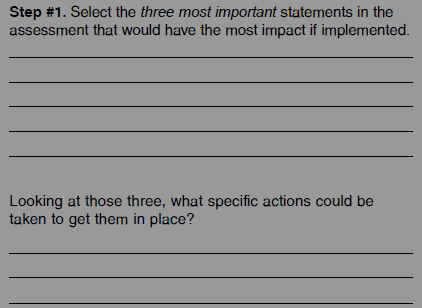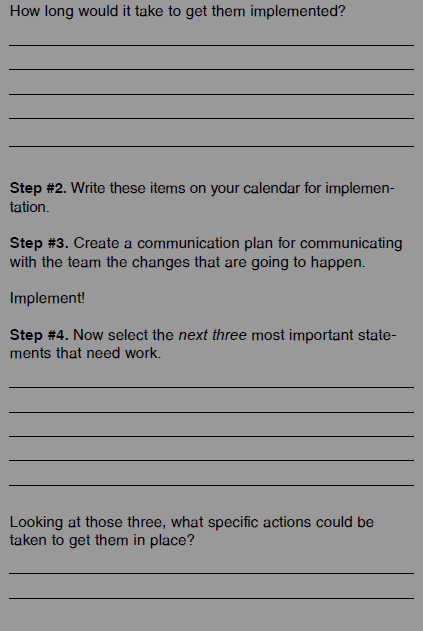An Action Plan
As Ben Franklin once said, “I have always thought that one man of tolerable abilities may work great changes, and accomplish great affairs among mankind, if he first forms a good plan, and, cutting off all amusements or other employments that would divert his attention, make the execution of that same plan his sole study and business.”
It is up to a manager, upon reading this book, to form a plan of action. Just hoping that some of the concepts will work will not be effective. There must be deliberate action and planning in order to create a motivating environment. The best approach is to have a very specific, detailed plan. The plan would answer the following questions:
• What do we need to do?
• Why is it important?
• Where will we do it first?
• Will it be in phases?
• When will it start?
• When will it need to be done?
• What are the components of the plan?
• How will the effectiveness be measured?
One word of caution: Managers should implement the plan over time. Trying to do the implementation all at once will ensure that the plan will fail. The implementation should be a phased approach over time. This will ensure that the plan will be as effective as possible. The plan should include the following main elements:
• Creating a motivating environment
• Crafting or reinforcing team purpose and mission
• Having passion in the work place
• Making a commitment to learning
• Coaching all employees for development
• Knowing what gets them motivated
• Designing rewards/incentives
• Creating a long-term plan for the team/department
• Understanding the importance of balance in each team member’s life
Once the plan has been formulated, it would be a good idea to review it with a colleague or a friend to double check that it makes sense. Then before execution, managers should run the plan by their manager. Once the plan is defined and in writing, it is time to implement the plan.
There should be a definite and obvious distinction between a plan for a new team and a plan for an existing team. If a manager is executing the plan with a new team, it is a different set of circumstances, and the ability to implement the plan might be a little easier because the team often expects changes to occur under new leadership. The manager has to work on establishing and setting a new climate and culture.
Implementing a plan for an existing team that has already been with that manager is more difficult because the stage has already been set. In this case, there are several challenges:
• Team members might have already made up their minds about the manager.
• The manager might have already taken some negative actions to create a non-motivating environment.
• If done too quickly, team members will wonder what in the world has “gotten into” their manager.
• The manager’s manager might already be comfortable with the existing style of the manager.
The key is a gradual, strategic approach to making changes over time. On the next page is an assessment to create an action plan for implementing changes, based on this book, in order to create an environment that is motivating.
This is an assessment that was completed earlier in the book on pages 2 through 3. In re-reviewing the answers, which ones stand out the most?

Follow the steps until the top ten statements have been reviewed and a strategy and time line have been created for each.
Once the planning is in place, it is a matter of scheduling the implementation of the plan and executing the plan. However, this does not by any means mean that it is done. The planning is good, but the process of employee motivation is continuous and constant. The team might be in good spirits and every thing might be “hunky dory.” Then there is a change in company policy, or nine million other factors that the manager can’t control, and several folks on the team are up in arms about it. It is time to manage again.
Management is a constant and ongoing process that happens daily, weekly, monthly, and throughout the year. There is absolutely no doubt that the manager is the largest contributor to employee motivation or lack of motivation. That applies to a factory, an office, or for that matter, even a hair salon.
Let’s take a look at Aldus Jackson, the owner of Aldus Jackson Salon and Spa in Parksburg, Pennsylvania, out in the suburbs of Philadelphia. When you walk into Aldus Jackson Salon and Spa, two things strike you immediately: the enthusiasm of the employees and the upscale, classy, warm, and visual impact of the salon.
Aldus has managed to create an environment that is positive and energized, and the employees swear by their boss. As it turns out, Aldus applies the very principles outlined in this book. Here are some of the concepts that Aldus applies and that we talked about when I interviewed him for this book:
• The work place. Aldus designed a work place that has a space for each stylist to work and not be cramped. In his words, “This is their business, too. They are sharing in this, and my success depends on their success.”
• Purpose. The employees understand the purpose of their work and come to the table with a “servant attitude” (including Aldus), and seeing customers transformed and feeling good about themselves has “a certain magic about it that is contagious.”
• Positive environment. Aldus tries daily to maintain a positive environment. If employees get stressed, he gently reminds them to “Relax. It will get done, and the end of the day will come.”
• Development. The employees have development classes where they have experts come and teach them new techniques and styles. He has also sent stylists to New York City for training.
• Communication. Once a month, a staff meeting is held for all team members to keep them “in the loop.”
• Hiring. Hiring of stylists is done with an eye toward their skill, but also to see if they are a fit with the organization. Aldus interviews each candidate several times and gets feedback from the employees about the candidate. “The fit with the group is everything. Their feedback is my safety net for not making the wrong choice.”
• Mirroring. Aldus is very aware that he has to mirror the values and qualities that he expects from his team. He makes sure (1) to be considerate to others, (2) to work as hard as they work, and (3) that everyone works together. He feels the most important value is integrity. “Integrity is all you have and if you approach each encounter with integrity, if you have that, then you can get up every morning feeling good about what you do.” He encourages employees to live those values. He had a stylist who did a coloring that was just slightly off. The guest was happy, Aldus was happy, but the stylist felt bad and wanted to do it over. “I was blown away by that—by her commitment to quality. I was very proud.”
• Reward. Employees are rewarded with compliments, and given unexpected extras when they perform beyond expectation. “I wish I could do more and strive to do more in that area.”
“As leaders, my hope for all of us is that we can create something to help make a great quality of life for our employees, their families, and our team.”
So no matter the business—a salon, a factory, a charitable organization, an office, a sport team—the concepts when applied work and are effective for motivating employees.
The concept of motivation seems foreign to some corporate environments, but is absolutely vital to corporate long-term success.
As the market for employees tightens in the next few decades, employees will have a choice as to where they want to work, and they will make this choice loud and clear. The key deciding factor for wanting to work and stay with an organization will be the motivating environment. Managers have to understand that they are a large contributing factor to that environment. In fact, they are the environment.




